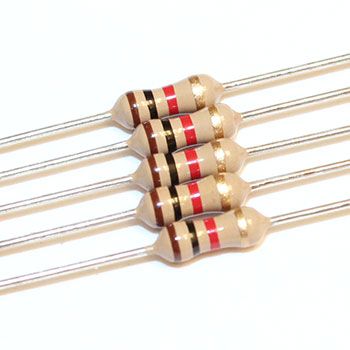In the vast world of electronics, few components are as essential and ubiquitous as the 10k resistor. From amateur hobbyist projects to advanced industrial designs, this simple device plays a pivotal role in shaping the performance and reliability of countless circuits. The 10k resistor is not only a staple in engineering kits but also a symbol of precision and control in the digital age. In this article, we will explore its rich history, significance, common myths, and future prospects.
The History of the 10k Resistor
Origins of Resistance
Resistors, as we know them today, trace their origins back to the 19th century when the principles of electrical resistance were being formalized. Ohm’s Law, formulated by Georg Simon Ohm in 1827, laid the groundwork for understanding the relationship between voltage, current, and resistance. However, it wasn’t until the 20th century, with the rise of electronic devices, that resistors became standardized components.
The 10k resistor, representing a resistance value of 10,000 ohms, became one of the most widely used standard resistor values. Its popularity is largely attributed to its inclusion in the E12 and E24 series of preferred resistor values, which offer logarithmic steps for optimal circuit design.
Why the 10k Resistor Is So Significant
A Standard in Electronics
The 10k resistor is considered a “go-to” value in many circuit designs. It strikes an ideal balance between current limitation and voltage drop, making it suitable for a variety of applications:
- Pull-up and pull-down resistors in digital circuits
- Biasing transistors in analog systems
- Voltage dividers for reference voltage generation
- LED current limiting when paired with appropriate voltages
Because of its versatility, engineers and technicians often reach for the 10k resistor first when prototyping or troubleshooting a circuit.
Educational Importance
In electronics education, the 10k resistor is one of the first components students encounter. Its usage helps illustrate foundational concepts such as Ohm’s Law, Kirchhoff’s rules, and series-parallel networks. For beginners, learning how a 10k resistor affects circuit behavior provides a stepping stone to more advanced designs.
Common Misconceptions About the 10k Resistor
Myth 1: “All Resistors Behave the Same”
A widespread misconception is that all resistors, including the 10k resistor, perform identically regardless of composition or quality. In reality, resistors vary in terms of tolerance, temperature coefficient, and power rating. For example, a 10k resistor made from carbon film might exhibit different performance characteristics compared to one made from metal film, especially under varying environmental conditions.
Myth 2: “More Resistance Is Always Better”
Some novice designers believe that using a 10k resistor instead of a lower-value resistor will always be safer or more efficient. However, in many cases, too high a resistance can cause signal distortion, reduce current flow to unacceptable levels, or prevent components like transistors from switching properly.
Myth 3: “You Only Need One Type of Resistor Value”
Another common misunderstanding is that a 10k resistor can replace most resistor values in a circuit. While it is highly versatile, proper circuit function often depends on precise resistance values tailored to specific electrical requirements.
The 10k Resistor in Culture and Innovation
In DIY and Maker Communities
The 10k resistor is a fan favorite in DIY electronics and maker culture. From Arduino starter kits to Raspberry Pi projects, this resistor appears in a wide range of tutorials and guides. It often serves as a bridge between creativity and functionality, allowing hobbyists to turn ideas into working prototypes.
Notable Uses in History
One of the earliest consumer electronics to widely utilize the 10k resistor was the transistor radio. These compact devices used 10k resistors in their biasing networks, helping to regulate current through transistors for optimal sound quality.
In the modern age, the 10k resistor continues to feature prominently in devices like remote controls, smart thermostats, and wearable technology. Its role may seem small, but without it, many systems would not function as intended.
Industrial Applications of the 10k Resistor
Embedded Systems
In microcontroller-based systems, the 10k resistor often plays a crucial role in ensuring reliable digital input readings. For instance, it is commonly used as a pull-up resistor to maintain a high logic level when switches or sensors are open.
Sensor Interfaces
Sensors like thermistors and photodiodes often use 10k resistors in voltage divider circuits to convert analog signals into readable data. This simple arrangement enables devices like temperature monitors, light detectors, and even heart rate sensors to function accurately.
Power Management
The 10k resistor is frequently employed in circuits to detect voltages and manage power flow. In battery-powered devices, it helps reduce unnecessary current draw while maintaining the necessary monitoring functions.
The Future of the 10k Resistor
Miniaturization and Integration
As electronics continue to shrink in size, the 10k resistor is being integrated into surface-mount device (SMD) packages and system-on-chip (SoC) designs. This trend allows designers to fit more functionality into smaller footprints without compromising on performance.
Smart Components
Researchers are exploring “smart resistors” with tunable properties that change in response to external stimuli such as temperature or light. While these technologies are still in their infancy, future versions of the 10k resistor could adapt in real-time to environmental conditions, making them ideal for next-generation sensors and AI applications.
Conclusion: More Than Just a Component
The 10k resistor may appear modest, but its impact on electronics is profound. It is a silent enabler of innovation, a teaching tool, and a versatile building block found in nearly every modern electronic device. Understanding its significance allows us to appreciate the engineering marvels that surround us every day.
As technology evolves, so too will the role of the 10k resistor—but its legacy as a cornerstone of circuit design is secure. Whether you’re a beginner soldering your first LED circuit or an engineer designing cutting-edge embedded systems, chances are you’ll reach for a 10k resistor at some point. And when you do, you’ll be using more than just a component; you’ll be tapping into a tradition of precision, simplicity, and reliability.
You may also read:
Melania Trump Young: A Look Into Her Early Life, Influence, and Legacy


